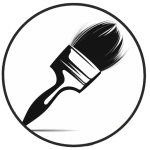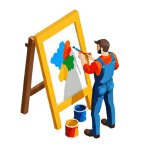Welcome to the Self-Guided Online Lesson: How to Paint
Exploring Painting Techniques for Aspiring Painters
Welcome, aspiring painters! In this self-guided online lesson, you will dive into the fascinating world of painting techniques. Whether you are a beginner looking to learn the basics or an experienced artist seeking to refine your skills, this lesson is designed to help you achieve your painting goals.
Through step-by-step instructions and detailed solutions, you will unlock the secrets of various painting techniques that will elevate your artwork to new heights. From mastering brush strokes to understanding color theory, this lesson will provide you with the tools and knowledge needed to create stunning and expressive paintings.
Get ready to unleash your creativity, experiment with different styles, and discover the joy of painting. Let's embark on this artistic journey together and explore the endless possibilities that painting has to offer!
Understanding basic painting techniques is essential for painters of all skill levels. These techniques form the foundation upon which you can build your painting style and develop your artistic expression.
One of the fundamental painting techniques is blending. Blending involves smoothly mixing two or more colors together to create gradients and transitions. To achieve a successful blend, use a soft brush and gentle strokes to seamlessly merge the colors on your canvas.
Another crucial technique is layering. Layering allows you to add depth and dimension to your painting by applying multiple layers of paint. Start with lighter colors as a base and gradually build up to darker shades to create a sense of realism and complexity in your artwork.
Furthermore, understanding the importance of brush control is key to mastering painting techniques. Experiment with different brush sizes, shapes, and textures to create various effects and details in your paintings. Practice varying your pressure and stroke techniques to enhance the overall visual appeal of your artwork.
Lastly, always remember the significance of light and shadow in painting. By mastering the interplay of light and shadow, you can create depth, contrast, and a sense of realism in your artwork. Pay attention to the direction of light sources and how they interact with different objects in your composition.
When it comes to mastering painting techniques, choosing the right tools and materials is crucial. Here are some essential items every painter should have in their arsenal:
Paintbrushes: Invest in a variety of paintbrushes in different sizes and shapes to achieve different effects. Flat brushes are great for covering large areas, while round brushes are perfect for detailed work.
Paint: Choose high-quality paint in the colors you need for your project. Acrylic paint is versatile and easy to work with, while oil paint offers rich colors and a glossy finish.
Palette: Use a palette to mix your paint colors. You can choose from a traditional wooden palette or a disposable palette pad for easy cleanup.
Canvas or Paper: Select the right surface for your painting. Canvas is durable and great for acrylics or oils, while paper works well for watercolors.
Easel: Invest in a sturdy easel to hold your canvas or paper at the right angle while you work. This will help prevent neck and back strain during long painting sessions.
By having the right tools and materials on hand, you'll be better equipped to explore and master various painting techniques with confidence.
Before you begin painting, it is crucial to properly prepare the painting surface to ensure the best results. Follow these steps to prepare your surface:
1. Clean the Surface: Start by cleaning the surface you plan to paint. Remove any dust, dirt, or debris by wiping it down with a damp cloth or using a mild detergent if necessary. A clean surface will help the paint adhere better and result in a smoother finish.
2. Repair Any Damage: Inspect the surface for any cracks, holes, or imperfections. Use a suitable filler or spackling compound to repair any damage. Allow the filler to dry completely before moving on to the next step.
3. Sand the Surface: Once the repairs are dry, lightly sand the surface to smooth out any rough patches and create a uniform texture. Use fine-grit sandpaper and be sure to wipe away any dust with a clean cloth before proceeding.
4. Prime the Surface: Applying a coat of primer is essential, especially if you are painting over a porous or uneven surface. Primer helps the paint adhere better, improves coverage, and enhances the durability of the finish. Choose a primer that is suitable for the type of surface you are painting.
By following these steps to prepare your painting surface, you will create a solid foundation for your painting project and achieve professional-looking results.
When it comes to exploring different painting styles, there are countless techniques and approaches that artists can experiment with to achieve unique and captivating results. Here are a few popular painting styles that you can try:
Impressionism: This style is characterized by loose, expressive brushwork and a focus on capturing the fleeting effects of light and color. To paint in the Impressionist style, try using short, broken brushstrokes and a vibrant color palette.
Realism: Realist painters aim to depict their subjects with a high degree of detail and accuracy. To paint in a realistic style, focus on capturing the precise proportions, textures, and lighting of your subject.
Abstract: Abstract art is all about using color, shape, and form to create a composition that is non-representational or distorts reality. Experiment with bold colors, geometric shapes, and expressive gestures to create your own abstract paintings.
Expressionism: Expressionist painters aim to convey emotion and mood through exaggerated colors, brushwork, and distortion of reality. To paint in an expressionist style, focus on conveying your feelings and emotions through your brushstrokes and color choices.
Remember, there are no strict rules when it comes to painting styles, so feel free to mix and match techniques from different styles to create your own unique approach. The key is to experiment, practice, and find a style that resonates with you as an artist.
Practice is essential in mastering painting techniques. Set aside dedicated time each day to practice different strokes, blending colors, and experimenting with textures. The more you practice, the more comfortable you will become with your tools and materials.
Seek feedback from other painters, instructors, or even online communities. Constructive criticism can help you identify areas for improvement and provide valuable insights into your work. Don't be afraid to ask for advice or suggestions on how to enhance your painting techniques.
When receiving feedback, approach it with an open mind and use it as a learning opportunity. Take note of the suggestions given and incorporate them into your practice sessions. Remember, feedback is a valuable tool for growth and improvement in your painting journey.
Keep Striving for Improved Results
As we conclude this lesson on painters and the importance of painting techniques, it is crucial to remember that achieving improved results requires dedication and practice. By mastering various techniques, you are not only enhancing your skills but also bringing your artistic vision to life on the canvas.
Review and Practice
If you feel the need to reinforce your understanding of the painting techniques discussed in this lesson, don't hesitate to review the material. Remember, practice makes perfect, so keep experimenting and honing your skills to see progress in your work.
Explore Further
Make sure to make use of the other lessons available in the course to broaden your knowledge and skills as a painter. Each lesson offers valuable insights and techniques that can contribute to your growth as an artist.
Lesson Audio


this is a test of comments – CB